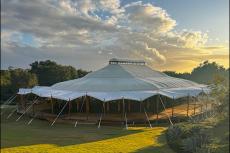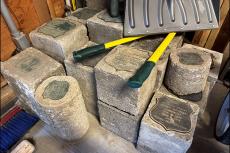Oysters were on the agenda when the East Hampton Town Trustees met Monday, a meeting that saw a new member of the board who is an oyster farmer speaking both as a trustee and as a resident of the community.
Sara Davison, executive director of the Friends of Georgica Pond Foundation, told the trustees that the foundation would like to repeat last year’s experimental introduction of oysters to the pond, which is under trustee jurisdiction. The foundation comprises a group of pondfront property owners who are concerned with the pond’s ecology; it has seen blooms of toxic cyanobacteria, or blue-green algae, in the last several summers. The foundation would fund the next introduction of oysters to the pond.
Oysters can filter 50 gallons of water daily, improving water clarity and reducing the intensity and prevalence of harmful algal blooms. “With a large enough population in a small embayment, the contribution to water quality improvement can be significant,” according to “The Eastern Oyster — Nature’s Engineer,” written by Ms. Davison for the foundation.
“It was a success, and we would like to repeat that,” she said of last year’s oyster project, which was overseen by Michael Doall, associate director of bivalve restoration at the Gobler Lab at Stony Brook University’s School of Marine and Atmospheric Sciences. Oysters spawned in 2018 and 2019 were grown in the pond in cages, at northern, central, and southern locations. The cages prevent predation, primarily by blue crabs, Ninety percent of the second-year oysters and 80 percent of the first-year specimens survived after four months in the pond, Ms. Davison reported.
Because of that success, she said, “we would like to expand it to try to grow some spat on shell — oysters outside the cage — to see how they survive in a more natural setting, with predation.” She also suggested that Mr. Doall would measure the oysters’ filtration at the Gobler Lab using water from the pond. “This project is all about, what role can oysters play in the pond to help improve water quality?” she said. “As an enclosed embayment, we want to have some real data about what the oysters might do, to get a sense of how many would make a difference in water quality.” Oysters are “a small fraction of the total picture of improving water quality,” she said, “but we wanted to quantify that.”
Conditions in Georgica Pond can vary from year to year, depending in part on how long it is open to the ocean. The trustees typically open a cut to the ocean in spring and fall. It closes naturally, though how long it remains open impacts the pond’s salinity.
Monday’s presentation followed one by Mr. Doall on Dec. 9, at which he called oysters “a major, important part of the ecosystem.” In large numbers, he said, they control phytoplankton abundance and improve water clarity, which helps fuel the growth of sea grasses, important habitat for invertebrates and fish.
Ms. Davison also sought and received the trustees’ permission to return an aquatic-weed harvester to the pond this summer; in past years the machine has removed macroalgae — which are believed to promote cyanobacteria — from the pond. The foundation has also applied for permits from the State Department of Environmental Conservation and the town, Ms. Davison said, with an additional request that the town allow use of a motorized skiff on the pond, which is typically not permitted.
The harvester was not employed last year but removed 93,140 pounds of aquatic macrophytes in 2018, a substantial increase over the prior two years.
Ms. Davison also asked the trustees’ blessing to install a new telemetry buoy in the pond in early March, replacing one that “bit the dust.” The solar-powered buoy continuously transmitted data such as the water’s temperature, dissolved oxygen, pH level, and cyanobacteria. The new one will add nitrogen and phosphorous sensors, an overabundance of which is also blamed for promotion of cyanobacteria, Ms. Davison said. “It’s extremely important to make linkages between what we’re seeing in the pond and what’s happening,” she said.
Also at the meeting, the trustees discussed the Suffolk County Aquaculture Lease Program, in which parcels are leased for private commercial shellfish cultivation, in Peconic Bay and Gardiner’s Bay. The 10-year-old program, known as SCALP, is presently under a required initial review, which will determine if and how it should be changed and implemented in 2020 and beyond.
The leasing of bottomlands led to a lawsuit by the Devon Yacht Club in Amagansett, which maintained that floating oyster cages interfered with boating activities. Several residents and officials of marinas and private clubs have also complained to the trustees that the lease sites were set based on input from commercial fishermen but not other stakeholders, and that the program assumed oyster cages would be on the bay bottom, not floating at the surface.
On Monday, Curtis Schade, the Devon Yacht Club’s commodore, asked if the trustees had considered what they will recommend to SCALP’s advisory committee. “Everyone who represents the residents of East Hampton . . . has to communicate what we think is best for the town, factoring in all constituents,” he said.
Rick Drew said that he and his colleagues have heard from four main constituencies: homeowners associations, marinas, yacht clubs, and oyster farmers. Jim Grimes likened the trustees’ Dec. 9 meeting, at which members of the public spoke for and against the program, to a public hearing. “The next step,” he said, “should be getting some of those oyster people, some of the other concerned groups, to . . . see if there’s something workable to all parties,” so that the trustees do not find themselves “trying to pick the lesser of two evils.” Relocating farming gear or making it more visible to boaters would address opponents’ concerns, he said.
Mike Martinsen, who owns the Montauk Shellfish Company and was elected to the board of trustees in November, indicated that he would recuse himself in any vote on recommendations. But speaking as a resident, he said, “I care most about the environment. When I look at the four groups as those that were heard, I see homeowners, marinas, oyster growers, yacht clubs. . . . I believe ‘environmental group’ needs to be listed as one of the five groups.”
“When it comes to moving gear, absolutely, there’s a consensus to be made,” Mr. Martinsen said. “There are many users of the water; we all need to work together, appreciate and respect each other’s love of the water.” All the groups can reach a consensus, he predicted.



